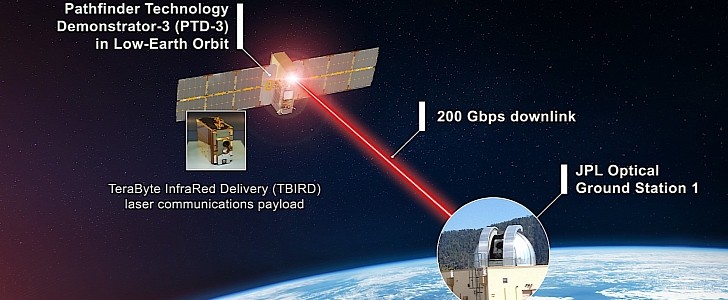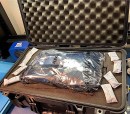With a slightly different spelling, the term TBIRD brings into the mind of the automobile enthusiast that incredible car Ford used to make starting with the 1950s and named Thunderbird. Sadly for the automobile enthusiast, this TBIRD is anything but a car.
In this case, TBIRD stands for TeraByte InfraRed Delivery. It’s a technology NASA has been working on in light of the upcoming missions to the Moon and later on to Mars, which will require much faster comms systems than we now have at our disposal.
Presently, the space agency mostly uses radio frequency to talk with spacecraft in space, but that’s a bit like using dial-up. A laser system is the equivalent of high-speed internet in this case, and this is what NASA is gunning for.
TBIRD launched yesterday on board the SpaceX Falcon 9 Transporter-5 (rocket’s launch in the video below), as part of the American space agency’s Pathfinder Technology Demonstrator 3 (PTD-3) mission. Once deployed in orbit, it will be used to demonstrate high-data-rate capabilities.
What does that mean? NASA hopes to have the thing (which is, in essence, a loaded CubeSat) fire up its communication tech and, during a seven-minute pass, to send back to Earth terabytes of data at 200 Gbps.
“TBIRD is a game changer and will be very important for future human exploration and science missions.” said in a statement Andreas Doulaveris, TBIRD’s mission systems engineer.
The tech will remain in orbit for the following six months, during which time the parties involved (the Goddard Space Flight Center, MIT, the Ames Research Center, JPL, and the Terran Orbital Corporation) hope to gather as much data on the capabilities of such a system.
At the time of writing, it’s not clear if or when such a technology could be deployed on an actual spacecraft.
Presently, the space agency mostly uses radio frequency to talk with spacecraft in space, but that’s a bit like using dial-up. A laser system is the equivalent of high-speed internet in this case, and this is what NASA is gunning for.
TBIRD launched yesterday on board the SpaceX Falcon 9 Transporter-5 (rocket’s launch in the video below), as part of the American space agency’s Pathfinder Technology Demonstrator 3 (PTD-3) mission. Once deployed in orbit, it will be used to demonstrate high-data-rate capabilities.
What does that mean? NASA hopes to have the thing (which is, in essence, a loaded CubeSat) fire up its communication tech and, during a seven-minute pass, to send back to Earth terabytes of data at 200 Gbps.
“TBIRD is a game changer and will be very important for future human exploration and science missions.” said in a statement Andreas Doulaveris, TBIRD’s mission systems engineer.
The tech will remain in orbit for the following six months, during which time the parties involved (the Goddard Space Flight Center, MIT, the Ames Research Center, JPL, and the Terran Orbital Corporation) hope to gather as much data on the capabilities of such a system.
At the time of writing, it’s not clear if or when such a technology could be deployed on an actual spacecraft.







